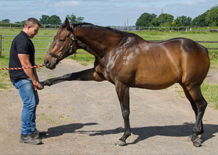MKJ Osteopathy
Registered member of the General Osteopathic Council, British Osteopathic Association and British Medical Acupuncture Society.
Fully insured by Balens.
Registered member of the General Osteopathic Council, British Osteopathic Association and British Medical Acupuncture Society.
Fully insured by Balens.

Animals, just like ourselves, can also suffer from muscular-skeletal problems which can give rise to pain, impede their performance and effect their quality of life in general. Issues can arise for various reasons such as falls, trips and injuries, or could be stiffness from new or increased work. It could be that they are suffering from arthritic changes in their joints, or need help after a surgical procedure. Whatever the cause, they can greatly benefit from osteopathic treatment and manipulation.
Veterinarians
Under current Veterinary Law only a Veterinary Surgeon can provide a diagnosis and treat an animal. However vets are increasingly referring cases to osteopaths where appropriate, but it is important to remember that it is an offence for any person to treat and animal without first seeking veterinary approval. To this end, prior to any treatment being undertaken, I would contact your vet to gain their approval for treatment to take place.
Osteopathy, or any other form of treatment is no substitute for veterinary care, and whilst it is possible to drastically reduce the reliance on prescribed medication, the animal should always remain under the primary care of their vet.
Training
In order to work with animals an Osteopath has to complete a year’s post-graduate training at an accredited centre. I trained under prominent Equine Osteopath Stuart McGregor at the Osteopathic Centre for Animals in Wantage and achieved a post-graduate diploma in Animal Osteopathy.
The training covered key aspects of Equine and Canine anatomy, biomechanics, pathology and equitation. Specific focus was given to the safe and effective application of the principles of Osteopathy and its techniques to both horses and dogs, which meant we spent a lot of time in stables and kennels gaining invaluable hands-on practical experience.
It is also a legal requirement that an Animal Osteopath be fully insured. Please feel free to check with Balens.co.uk if you have any concerns.

Price may vary depending on distance travelled, and the number of horses treated in that location.
Horses: